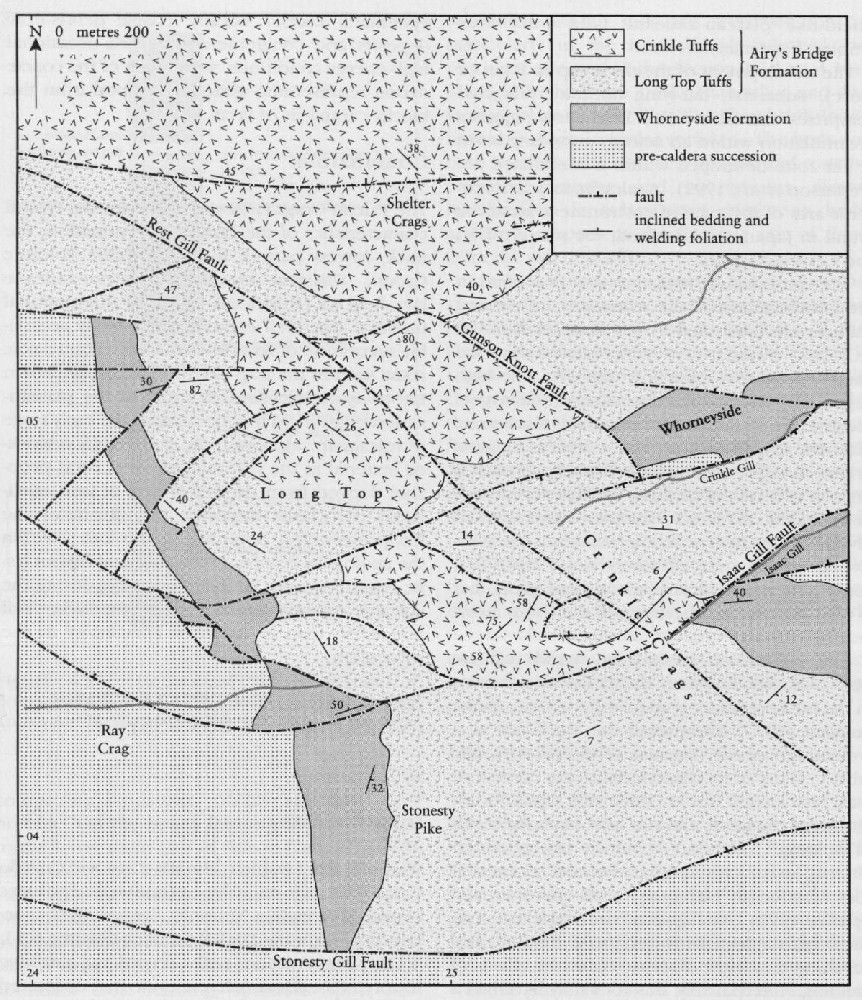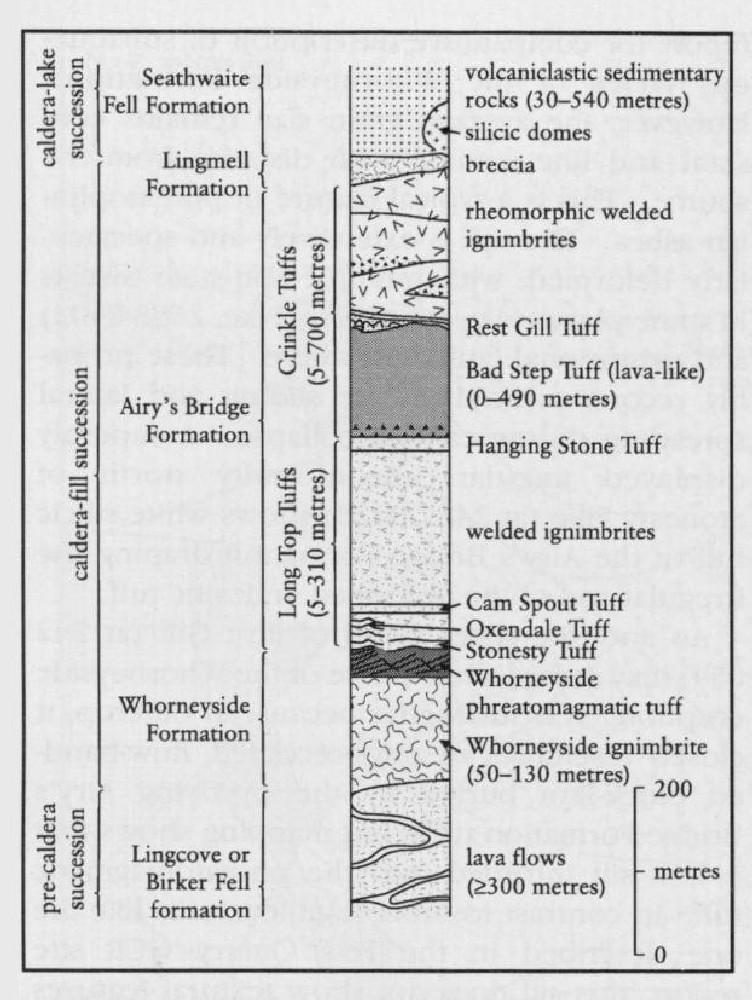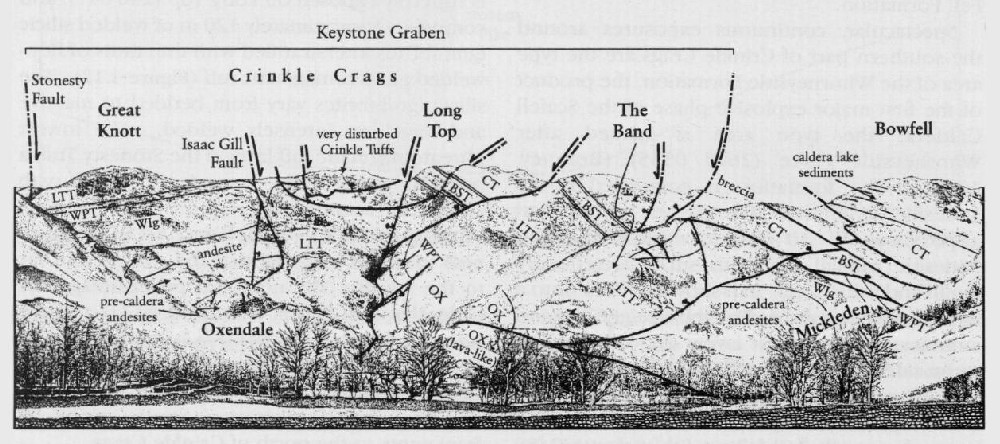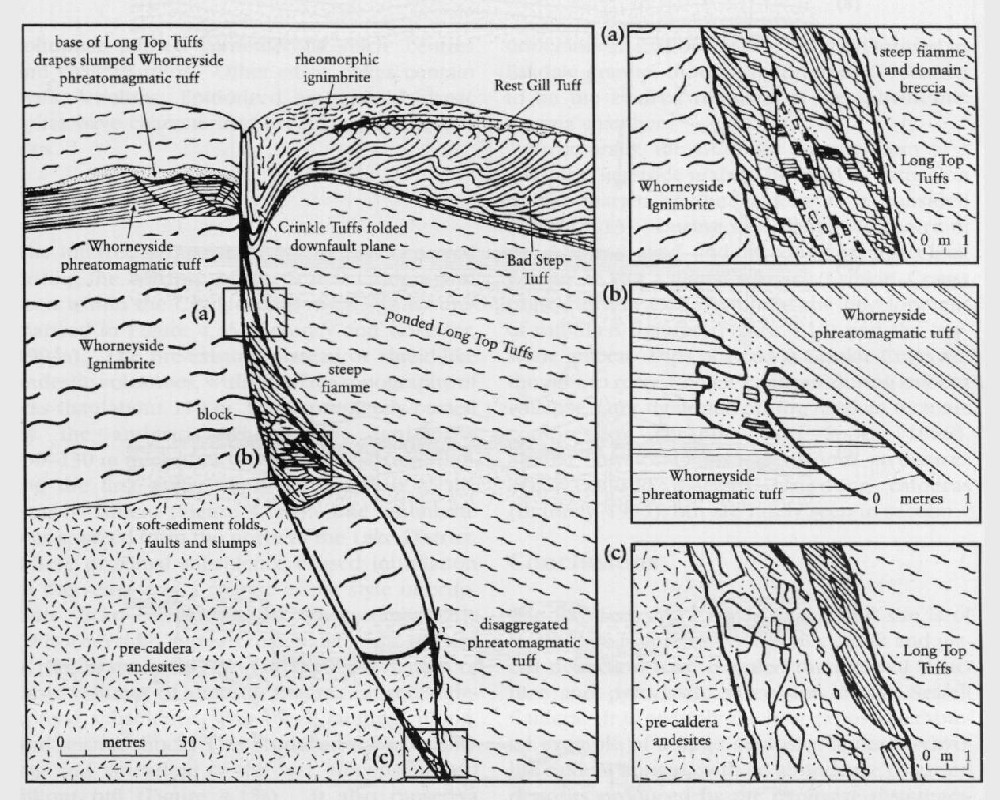Ray Crag and Crinkle Crags
[NY 241 0380]–[NY 265 055]
M.J. Branney
Introduction
West of Great Langdale, the Ray Crag and Crinkle Crags GCR site provides exceptional exposures of the Borrowdale Volcanic Group (BVG) succession within the Scafell Caldera (Figure 4.11), (Figure 4.12). The volcanic rocks record the eruptive history of a caldera-collapse cycle that fluctuated from magmatic to phreatomagmatic as vent regions were periodically flooded during the subsidence (Branney and Kokelaar, 1994a). The phreatomagmatic eruptions were large in scale; one of the ash-fall layers records the largest magnitude phreatoplinian eruption yet documented (Branney, 1991), and evidence for its origin by subaerial fallout and for its subsequent seismically induced deformation when the caldera subsided is superbly exposed. The exhumed internal structure of the Scafell Caldera shows how it fractured into many fragments as it collapsed; this has become known as 'piecemeal' caldera collapse. Criteria to distinguish volcanotectonic faults and to determine movement histories are exhibited in cross section on Crinkle Crags. Many of the faults show complex movement histories, and the fault scarps they produced shed rock avalanches into the subsiding caldera. Tuff-filled fissures and a graben at Crinkle Crags record localized extension caused by downsagging of the caldera floor during subsidence (Branney, 1995).
The geology of Crinkle Crags was described by Green (1913), Hartley (1932), and Oliver (1961), but it was not until the late 1980s that the 15 km-diameter Scafell Caldera was recognized (Branney and Soper, 1988; Branney, 1988b; Davis, 1989). The GCR site is of international importance because it provides unique information about the architecture of large hydrovolcanic calderas, and shows how their eruptions and collapse geometries evolve during subsidence. Type localities of many of the formations and members that comprise the caldera-fill succession are within the site. Fuller descriptions of the many geological features exhibited are given in Branney (1988b, 1990a, 1991, 1995), Davis (1989), Branney et al. (1992) and Branney and Kokelaar (1994b, 1994c); geological maps of the Scafell Caldera are published by the British Geological Survey as 1 : 50 000 sheets 29 (1999) and 38 (1996), and in Branney and Kokelaar (1994a).
Description
The oldest rocks within the GCR site are lavas that pre-date the onset of the major explosive volcanism associated with the Scafell Caldera (Branney, 1988b, 1990a). On Ray Crag [NY 243 042], west of Crinkle Crags, thin subaerial, amygdaloidal pahoehoe, aa, and blocky basaltic-andesite lavas are displayed, probably to the best advantage of any locality in Britain (Figure 4.11). The lavas are interstratified with thin beds of basic tuff and volcaniclastic sedimentary rock. These belong to the Lingcove Formation of Branney and Soper (1988) and Branney and Kokelaar (1994a) and Ray Crags is the type locality for the formation. Petterson et al. (1992) and Millward et al. (in press) included these rocks as part of the Throstle Garth Member of the Birker Fell Formation.
Spectacular, continuous exposures around the southern part of Crinkle Crags are the type area of the Whorneyside Formation, the product of the first major explosive phase of the Scafell Caldera; the type area is named after Whorneyside Force [NY 2615 0535] (Branney, 1991). The formation is composed of an andesitic ignimbrite that passes up into an approximately 30 m-thick, thinly bedded andesitic ash-fall tuff with small accretionary lapilli and ash pellets. Ash-shower fallout onto a land surface is indicated by the size grading and stratification, by fallout layers that drape small steep-sided erosional rills cut by ephemeral streams, and by an absence of subaqueous facies (Branney, 1991). Impact structures occur at the base of some larger fallout lithic clasts [NY 2488 0406], the maximum size of which increases systematically northwards, indicating a vent position to the north (see the Sour Milk Gill GCR site report for comparative description of subaqueous facies of the Whorneyside Formation). However, the average grain size remains constant and fine grained with distance from the source. This is a typical feature of phreatoplinian ashes. The tuff is extensively and spectacularly deformed, with multiple soft-state thrusts in some places (e.g. at Stonesty Pike, [NY 2488 0402]) and extensional faults elsewhere. These probably record surficial gravity sliding and lateral spreading during caldera collapse. A superbly displayed angular unconformity north of Stonesty Pike at [NY 2487 0420] shows white silicic tuff of the Airy's Bridge Formation draping the irregular top of the deformed andesitic tuff
An andesite sheet south of Rest Gill at [NY 242 054] may record a late phase of the Whorneyside eruption. It is instructive because at outcrop, it closely resembles an autobrecciated, flow-banded block-lava buried by the overlying Airy's Bridge Formation tuffs, but mapping shows that it is a sill intruded into the phreatomagmatic tuff. In contrast to other high-level sills like the one described in the Pets Quarry GCR site report, this sill does not show textural features that are diagnostic of an intrusive origin, such as spalled hydroclasts and local steam-vesiculation of the host deposit; it would probably be taken to be a lava but for its locally discordant contacts.
The overlying Airy's Bridge Formation, the type area of which is on Crinkle Crags, is divided into two. The lower part, the Long Top Tuffs, is superbly exposed on Long Top [NY 246 047], and comprises approximately 120 m of welded silicic ignimbrites interstratified with thin units of non-welded phreatomagmatic tuff (Figure 4.12). The silicic ignimbrites vary from bedded to massive and most are intensely welded. The lowest phreatomagmatic tuff layer is the Stonesty Tuff, a bedded, white, flinty, formerly vitric, tuff with abundant accretionary lapilli qtype locality: Stonesty Pike, [NY 2488 0403]; (Figure 4.11)). Its thickness variation suggests that the source vent lay to the south. The next two phreatomagmatic beds, the Cam Spout Tuff [NY 2445 0474] and the Hanging Stone Tuff [NY 2841 0442], are both extensive, cream-coloured accretionary lapilli-bearing, cross-bedded pyroclastic surge and ash-fall layers, that record phreatomagmatic eruptions from vents to the north of Crinkle Crags.
The upper part of the Airy's Bridge Formation, the Crinkle Tuffs, comprises silicic ignimbrites that are more intensely welded than Bad Step Tuff (type area: Bad Step, [NY 2487 0481], near the summit of Crinkle Crags). This unit is of particular interest because it shows extreme welding. It is flow-banded, flow-folded, auto-brecciated and lava-like, and is indistinguishable from a rhyolite block lava, except near its base where, instead of having a widespread basal autobreccia that is typical of block-lavas, it is commonly unbrecciated and has well-preserved pyroclastic textures. Around Bad Step, and on the eastern slopes of Shelter Crags [NY 2530 0553], the basal part of the Bad Step Tuff is a poorly stratified pyroclastic breccia with a welded tuff matrix. The fiamme-bearing eutaxitic matrix has siliceous nodules and grades upward into lava-like rock with siliceous nodules, indicating that the entire unit was deposited by a single hot pyroclastic flow (Branney et al., 1992). The breccia is a rare UK example of a co-ignimbrite lag breccia (Walker, 1985), commonly used to indicate proximity to ignimbrite source vents.
The Bad Step Tuff is separated from overlying rheomorphic ignimbrites of the Crinkle Tuffs by the Rest Gill Tuff, a distinctive, laminated, turquoise fine to coarse tuff, less than 2 m thick, and thought to be the product of an extremely wet phrcatomagmatic eruption. It is named after Rest Gill [NY 2446 0558] where it is well displayed, showing evidence of contemporaneous the underlying Long Top Tuffs, and contain local reworking by surface water. The overlying superb rheomorphic folds and lineations. The thick, massive, garnetiferous welded ignimbrites lowest of these ignimbrites is the garnetiferous have eutaxitic and parataxitic welding fabrics, the latter with a rheomorphic lineation; locally in high-strain zones the fabric is flow-banded. The ignimbrites contain numerous lenses of mesobreccia, formed from rock avalanches produced by unstable, growing caldera-fault scarps. Some mesobreccia has a welded tuff matrix (e.g. at [NY 2487 0559] and fiamme have been deformed plastically around rigid blocks during compaction while the deposit was still hot.
The internal structure of the Scafell Caldera is well displayed on Crinkle Crags. Many closely spaced volcanotectonic faults are exposed in plan and in section (Figure 4.11), (Figure 4.13). For example, the Isaac Gill Fault (Figure 4.14) is a superb example of a caldera-floor fault that moved prior to the lithification of wet phreatomagmatic tuff, and before some of the ignimbrites cooled down and became brittle (Branney, 1988b). On the east side of Crinkle Crags, the Whorneyside phreatomagmatic tuff has slumped down the fault plane resulting in steeply inclined bedding, intense soft-state disruption, disaggregation, and local incorporation of angular blocks of Whorneyside ignimbrite. Welded silicic ignimbrites show evidence of hot ductile shear and folding adjacent to the volcanotectonic faults (Figure 4.14). The thickness of successive pyroclastic units changes abruptly across the faults, which allows the complex movement history of individual faults to be constrained (Branney and Kokelaar, 1994a).
Acid and basic dykes cut the succession at Crinkle Crags, for example on Stonesty Pike [NY 2491 0385], Great Cove [NY 2515 0470] and Rest Gill [NY 2448 0520]. They include porphyritic rhyolite and altered basalt; composite dykes have columnar jointed garnetiferous silicic centres and basic margins. Other silicic dykes contain mafic xenoliths. Epidotized, amygdaloidal basic dykes have characteristic irregular, chilled margins.
Interpretation
The inferred sequence of events that occurred during the collapse of the Scafell Caldera and seen within the Crinkle Crags GCR site is summarized in (Figure 4.15) (Branney and Kokelaar, 1994a). The pre-existing plateau or shield-like andesite volcanoes, with a surface topography of less than about 110 m, were completely buried by the andesitic Whorneyside ignimbrite (50–130 m thick after welding compaction) during the first major explosive eruption of the Scafell Caldera (Figure 4.15)a. The ignimbrite was sourced from the north of the Lake District, where proximal subsidence caused inundation of the vents, and a change in the style of eruption from magmatic to phreatomagmatic (Whorneyside phreatomagmatic tuff; (Figure 4.15)b; Branney, 1991). The rapid evacuation of large volumes of andesitic magma caused widespread subsidence, with block faulting, tilting, and seismic shock. This produced soft-state sliding and spreading of the wet, unconsolidated fallout tuff (Figure 4.15)c. It also caused a change in vent position and the onset of silicic explosive ignimbrite eruptions, that rapidly buried and preserved the slumped Whorneyside phreatomagmatic tuff (Figure 4.15)c. There followed a fluctuation between explosive magmatic eruptions producing hot ignimbrite and violent phreatomagmatic eruptions (Long Top Tuffs). Piecemeal caldera subsidence continued, and the hot ignimbrites deformed in a ductile manner at the numerous active volcanotectonic faults (Figure 4.15)d. The fault scarps collapsed locally, generating hot rock avalanches. During the climax of the eruption, thick high-grade rheomorphic ignimbrites were emplaced and localized subsidence accelerated (Figure 4.15)e. Finally, the caldera became flooded, forming a large caldera lake (Figure 4.15)f. The subaqueous sedimentary rocks and tuffs that buried the caldera-fill ignimbrites, and the post-collapse silicic domes are considered in the Langdale Pikes and Rosthwaite Fell GCR site reports. The succession was subsequently intruded by dykes and pervasively altered hydrothermally, a typical feature of modern caldera fills. The area is underlain at shallow depths by the Ordovician Eskdale granite, thought by Branney (1988a, b) to be the evolved remnant of the subvolcanic magma chamber.
Structurally, the GCR site has the form of a complex 'keystone graben', formed by extension at the margin of the caldera as it subsided (Figure 4.13). During subsidence the centre of the caldera sagged, and the resultant monoclinal flexing at the caldera margin (Crinkle Crags) caused brittle extension, and the development of tuff-filled fissures (Figure 4.14) and the keystone graben. Dips of strata at Crinkle Crags are thought to record block rotations during caldera collapse, later tightened during Acadian tectonic compression (Branney and Soper, 1988). Similar keystone-type extensional structures occur around margins of young calderas (Branney, 1995), but are rarely seen in section.
Conclusions
The Ray Crag and Crinkle Crags GCR site is of international importance because uplift and glacial dissection have revealed the internal structure and pyroclastic succession of the Scafell Caldera. It is possibly the best-exposed exhumed example of a large explosive andesite-rhyolite caldera known, with an abundance of varied deposits produced by the explosive disintegration of magma by water. Most modern calderas of this type are inaccessible because they are flooded or buried by their erupted products. Therefore, an understanding of the Scafell Caldera provides important insights into the evolution and possible internal structure of modern, hazardous, flooded caldera volcanoes, like Taal (Philippines), Santorini (Greece), Kikae (Japan) and Rabaul (Indonesia).
Crinkle Crags exhibits a 'piecemeal' caldera structure resulting from the differential foundering of adjacent caldera-floor fault blocks. Such complexity was not widely envisaged for calderas prior to the 1980s. Several continuously exposed faults can be traced down through the caldera stratigraphy into the caldera floor. These faults grew in a complex way during the eruption, and they display features that readily distinguish them from other types of faults. The stratified caldera-fill succession allows reconstruction of how a caldera subsides progressively with time, and how the corresponding eruptive activity varies. Most caldera fills studied previously are non-stratified, preventing detailed reconstruction of caldera evolution during collapse.
Crinkle Crags is the type locality of the Whorneyside Formation, which records the largest-magnitude explosive eruption yet documented that was produced by large volumes of water coming into contact with magma. The GCR site is also the type area for the Airy's Bridge Formation, which includes some of the best examples in Britain of cross-bedded pyroclastic surge deposits, garnet-bearing welded ignimbrites, avalanche deposits, and lag breccia associated with ignimbrite. The very densely welded ignimbrites, including one that is so intensely welded that it resembles a flow-banded, flow-folded lava, are unusual among calc-alkaline ignimbrites. Finally, on Ray Crag are excellent examples of pahoehoe, as and blocky basic lavas that were erupted prior to the major explosive phase of the Scafell Caldera.
References





